Intel announces details of next-generation notebook processor 'Lunar Lake' with emphasis on AI performance and power efficiency
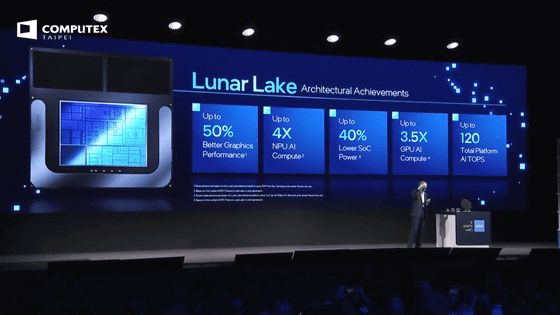
Intel announced details of its next-generation notebook processor '
Computex: Intel accelerates AI everywhere, redefining power, performance, and affordability.
https://www.intel.co.jp/content/www/jp/ja/newsroom/news/computex-2024-ai-everywhere-power-performance-affordability.html
Architecture All Access: Live at Lunar Lake ITT: Lunar Lake Architecture Overview - YouTube
Intel Unveils Lunar Lake Architecture: New P and E cores, Xe2-LPG Graphics, New NPU 4 Brings More AI Performance
https://www.anandtech.com/show/21425/intel-lunar-lake-architecture-dive-lion-cove-xe2-and-npu4
Intel's Lunar Lake is a laptop processor that focuses on improving power efficiency and optimizing overall performance from Meteor Lake, which was released in 2023. At the time of writing, the lineup after the 12th generation Core processor ' Alder Lake ' is as follows. The Lunar Lake announced this time is not manufactured at Intel's foundry, but is characterized by the use of TSMC's N3B and N6 manufacturing processes.
| Alder/Raptor Lake | Meteor Lake | Lunar Lake | Arrow Lake | Panther Lake | |
| P-core (high performance core) architecture | Golden Cove/ Raptor Cove | Redwood Cove | Lion Cove | Lion Cove | Cougar Cove? |
| E-Core (High Efficiency Core) Architecture | Gracemont | Crestmont | Skymont | Crestmont? | Darkmont? |
| GPU Architecture | Xe-LP | Xe-LPG | Xe 2 | Xe 2? | ? |
| NPU Architecture | none | NPU 3720 | NPU 4 | ? | ? |
| Manufacturing Process | Intel 7 | Intel 4 TSMC N6 TSMC N5 | TSMC N3B TSMC N6 | Intel 20A etc. | Intel 18A |
| Featured Devices | Notebook PC desktop | Notebook PC | Energy-efficient notebook PC | High-performance notebook PC desktop | Laptop? |
| Release Date | October to December 2021 | October to December 2023 | October to December 2024 | October to December 2024 | 2025 |
◆Lion Cove P Core
The high-performance P core uses a new architecture called 'Lion Cove.'
Architecture All Access: Lion Cove P-core Microarchitecture Explained - YouTube
Lion Cove is designed with improved single-threaded performance in mind, with improved memory and cache subsystems, better power management, and faster frequencies.
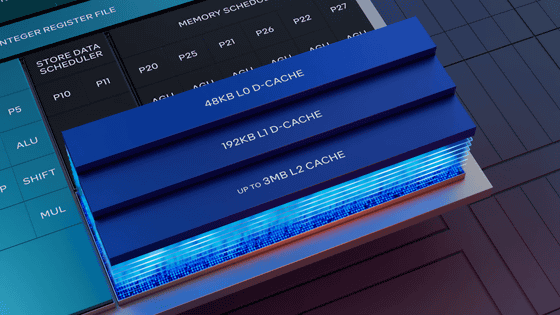
Lion Cove has significant front-end improvements, including 8x predicted blocks, wider
According to Intel, Lion Cove will deliver a significant improvement in instructions per cycle (IPC) compared to the previous generation Redwood Cove. In particular, hyper-threading will improve IPC by 30% and dynamic power efficiency by 20%. In addition, the power management will be equipped with an AI self-tuning controller that dynamically responds to the operating environment and delivers sustained higher performance.
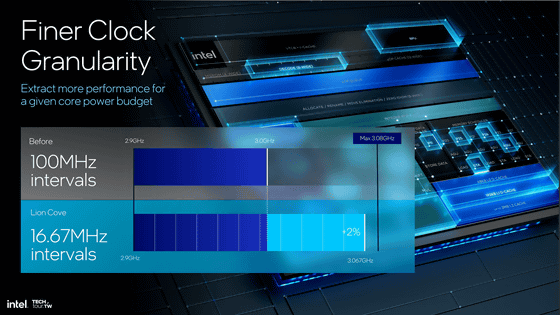
◆Skymont E-Core
The highly efficient E-core uses the Skymont architecture.
Skymont has an improved front end and out-of-order execution for more efficient performance, and by sharing a 4MB L2 cache across four cores, it doubles the L2 bandwidth to 128B per cycle, reduces memory access latency, and improves data throughput.
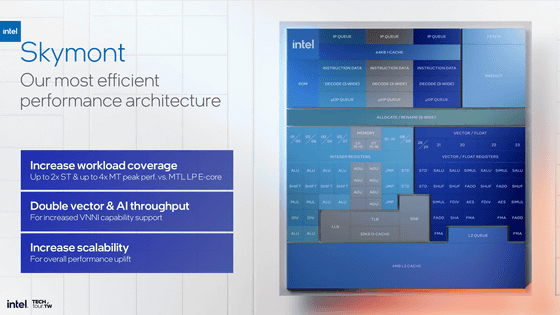
Compared to Meteor Lake's LP E-cores, Lunar Lake's Skymont E-cores consume one-third the power and deliver 2.9x better multi-core performance.

In terms of single-threaded performance, Intel claims that the Skymont E-core offers a 2% improvement in integer and floating-point performance compared to the Raptor Cove P-core, the P-core two generations earlier.
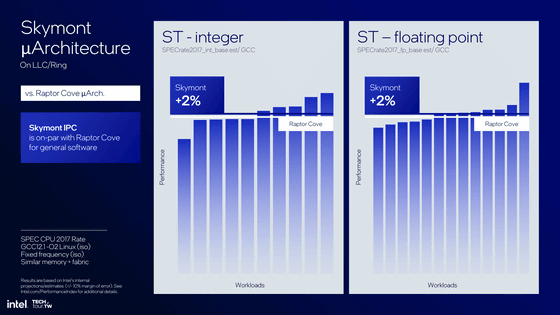
◆Xe 2 architecture
Xe 2 is a GPU architecture for notebook PCs supported by the second-generation Xe core. The second-generation Xe core is said to have 1.5 times the graphics performance compared to the Xe-LPG installed in Meteor Lake, thanks to the
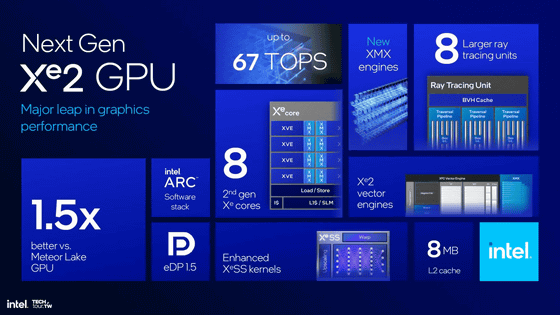
And Xe 2 supports
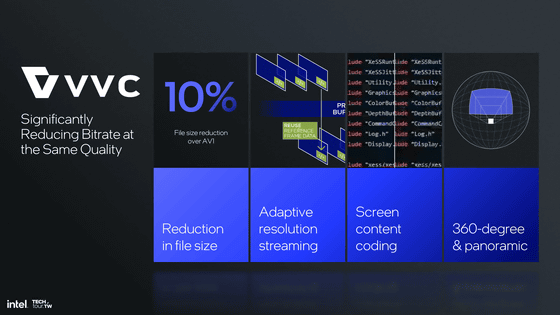
In addition, Intel has released a movie comparing the power consumption of a 4K quality YouTube AV1 movie played on a notebook PC equipped with Lunar Lake and Meteor Lake. From this, it is clear that Lunar Lake is more power efficient than Meteor Lake.
In addition, Xe 2 implements the Windows GPU software stack, providing comprehensive support for many runtimes and followers, including D3D, Bulkan and Intel VPL APIs and frameworks, improving overall efficiency and compatibility across a wide range of software environments.
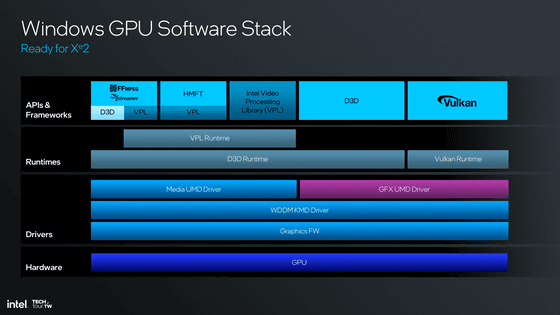
◆NPU 4
And the biggest focus of the Lunar Lake processor is the inclusion of NPU 4. The computing performance of the previous generation NPU 3 was up to 11.5 TOPs, while the NPU 4 has been improved to 48 TOPs.
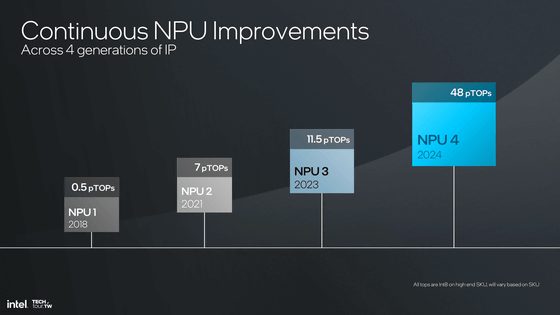
Compared to the previous generation, NPU 4 has three times the number of compute tiles.
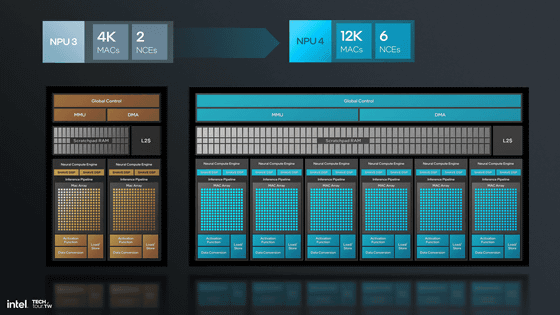
In addition, the efficiency of the multiply-accumulate unit (MAC) array has been improved, resulting in up to 2x performance at the same power level as the previous generation. The new MAC array features advanced data transformation capabilities to minimize latency and optimize data flow, allowing it to process up to 2048 MAC operations in one clock cycle for NT8 and 1024 MAC operations for FP16. In addition, the vector register length of the NPU 4 is now 512 bits, allowing more vector operations to be performed in one clock cycle.
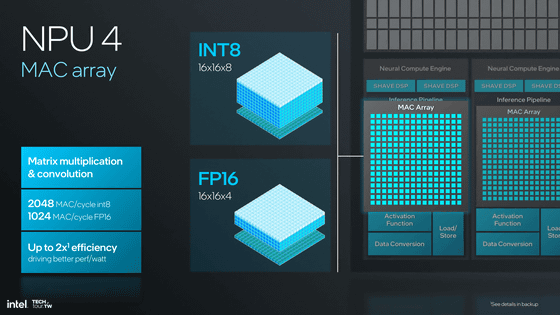
As a result, the NPU 4 delivers 12x the vector performance, 4x the TOPS, and 2x the IP bandwidth compared to the previous generation NPU 3. These improvements make the NPU4 highly efficient and optimized for machine learning applications that demand performance and low latency.
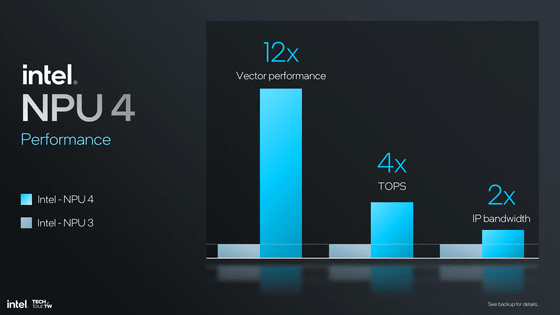
For I/O, the Lunar Lake processor is natively equipped with Thunderbolt 4, Thunderbolt Share, and Wi-Fi 7 connections. As for Thunderbolt 4, it is now possible to equip a laptop with three Thunderbolt ports, which improves convenience. Lunar Lake also has a system called '
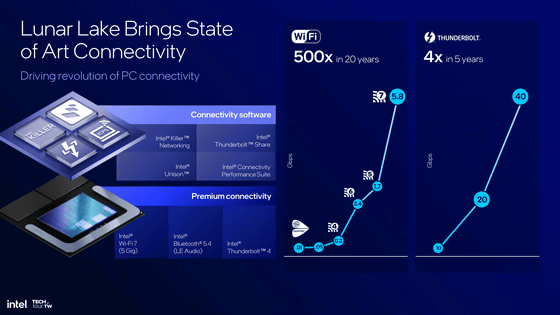
Lunar Lake's native support for Wi-Fi 7 will enable faster wireless communication for devices equipped with the chip. In addition, Lunar Lake is equipped with 'RF interference mitigation technology' that automatically adjusts the DDR clock frequency to minimize interference with Wi-Fi wireless signals. Intel claims that this reduces throughput degradation due to memory noise by 50%.
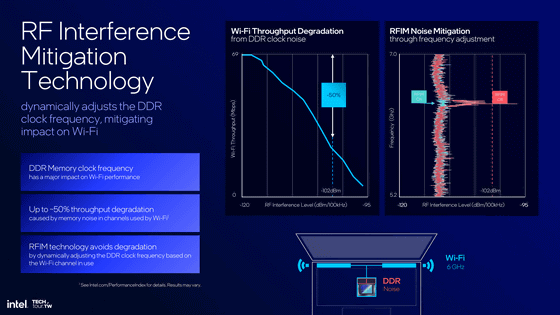
Of course, Wi-Fi 7 will enable high-speed wireless communication, enhancing the VR experience.
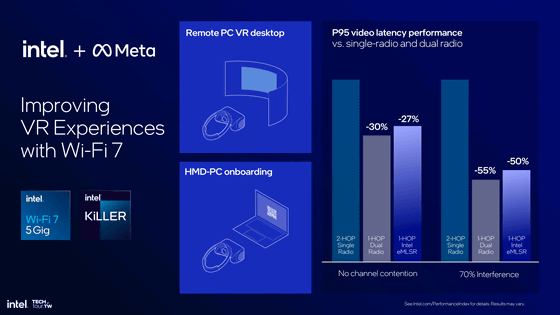
Lunar Lake is scheduled to be released to the market in the third quarter (October to December) of 2024. Intel has also announced that Arrow Lake for desktop PCs and high-performance laptops will be released at the same time as Lunar Lake, but details of Arrow Lake have not been revealed at the time of writing.
Related Posts:







